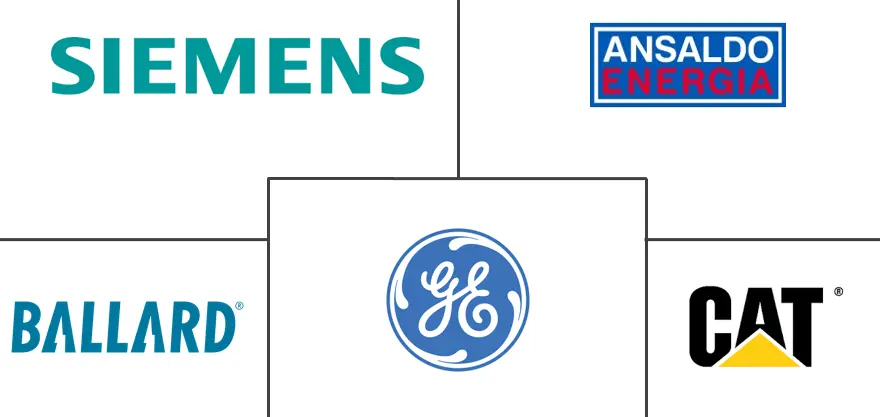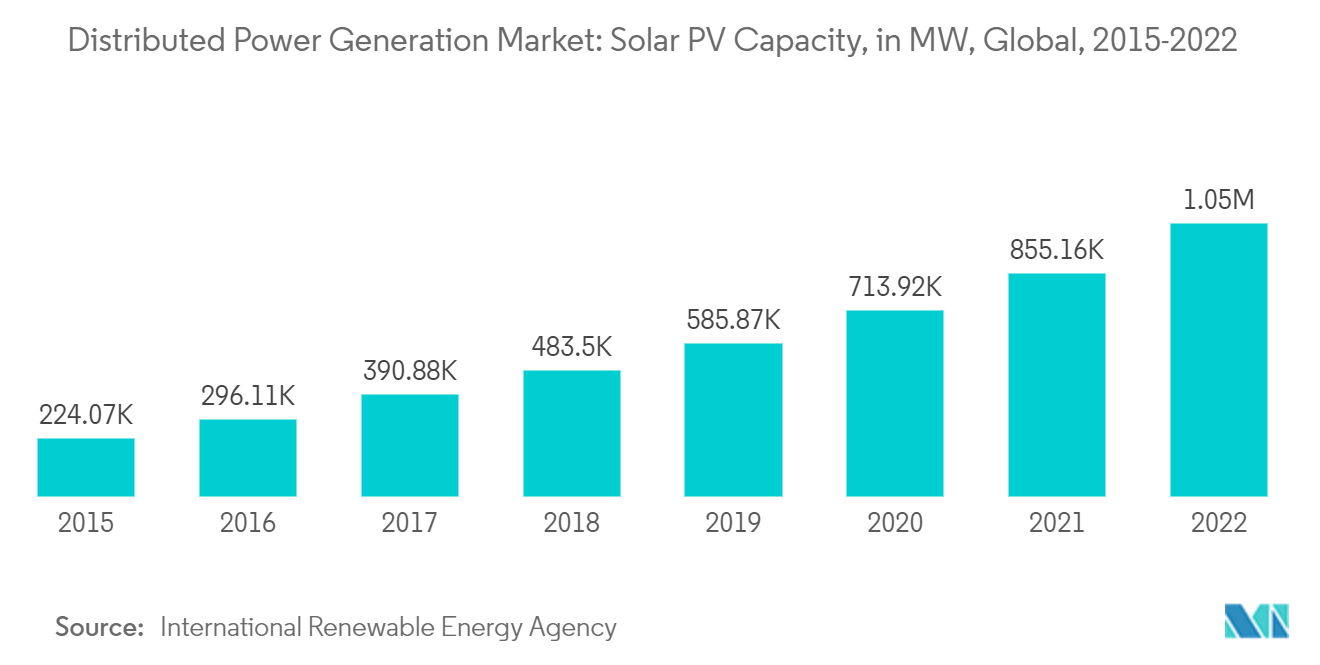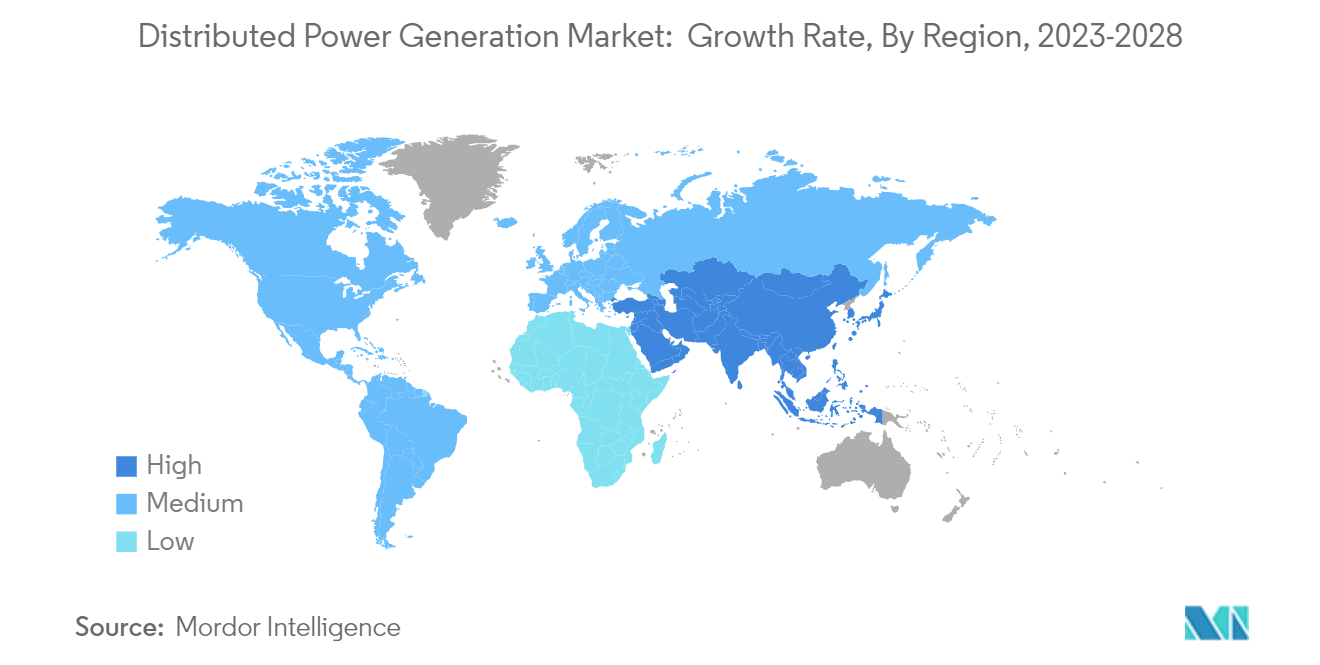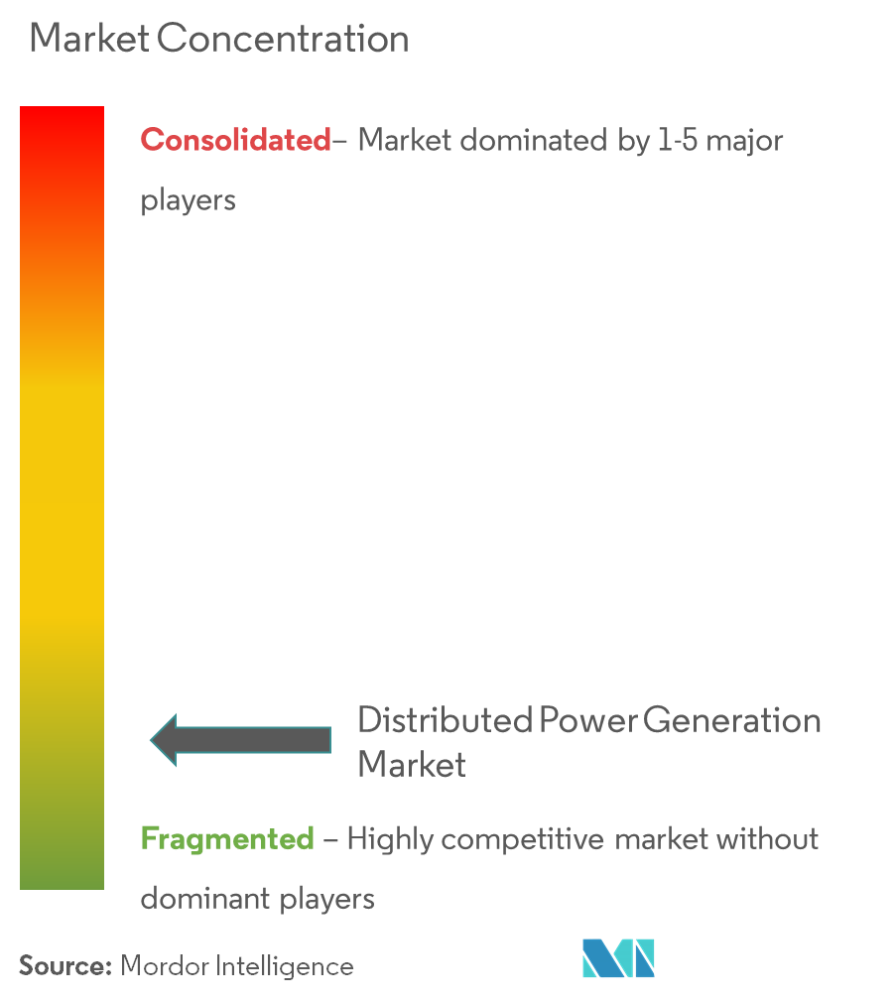Distributed Power Generation Market Size

| Study Period | 2020 - 2029 |
| Base Year For Estimation | 2023 |
| CAGR | 8.00 % |
| Fastest Growing Market | Asia Pacific |
| Largest Market | Asia Pacific |
| Market Concentration | Medium |
Major Players
*Disclaimer: Major Players sorted in no particular order |
Distributed Power Generation Market Analysis
The distributed power generation market is expected to register a CAGR of more than 8% during the forecasted period.
COVID-19 negatively impacted the market in 2020. Currently, the market has reached pre-pandemic levels.
- Over the medium term, the increasing shift toward renewable distributed power generation, mainly distributed solar PV installation, owing to declining renewable power generation and system costs, coupled with supportive government policies worldwide.
- On the other hand, consumers tend to prefer grid power over off-grid power owing to the low initial investment and no space requirement to generate electricity. This is expected to hamper the growth of the distributed power generation market over the forecast period.
- Nevertheless, the growing environmental concerns, international mandates to curb carbon emissions, and conducive policies by the governments of several countries to install renewable energy sources provide an opportunity for the distribution power generation market.
- Asia-Pacific holds the largest market share and has witnessed increasing energy demand in countries such as China, India, and ASEAN member states. China has a widespread manufacturing sector, which creates a need for power for operations. Thus, distributed power generation is used in this region to supply uninterrupted power.
Distributed Power Generation Market Trends
Solar PV to Dominate the Market
- The residential segment is expected to expand rapidly over the forecast period. Off-grid rooftop solar PV equipped with an energy battery storage system provides reliable secondary power to residential households, thereby boosting product demand across the segment. The deployment of large-scale storage systems to protect against peak demand power changes has resulted in the adoption of extra-large rooftop solar PV systems to store desired power in batteries.
- Rooftop Solar energy systems can be built, depending on the requirements. It enables consumers to save on their electric utility bills. Solar installations in households are called behind-the-meter solar," since the meter captures how much electricity the consumer is purchasing from a utility. Since distributed solar energy systems are called behind-the-meter, consumers do not pay the utility for the solar power generated.
- According to the location, the solar panels only convert between 15% and 20% of the total solar irradiation at noon on a bright, sunny day into electricity. The polycrystalline or monocrystalline panels are installed on rooftops, open grounds, or walls, with the front facing the sun, to produce sufficient energy in a day.
- As per International Renewable Energy Agency (IRENA) statistics, in 2022, the solar photovoltaic energy capacity was around 10,46,614 MW, up by 22.4% from the previous year. In the period under consideration, figures presented a trend of continuous growth.
- With the downward trend of solar panel and battery storage prices and declining construction costs, establishing distributed PV with a battery storage system and evacuating solar energy at 11 kV or 33 kV is an attractive proposition. It will reduce transmission line losses, increase grid resilience for rural feeders, avoid transmission distribution losses, reduce generation costs, and reduce investment costs in new utility generation capacity.
- Hence, due to technological interventions in solar PV, the declining cost of electricity generation and ease of construction of solar systems are expected to drive the distributed power generation market.

Asia-Pacific to Dominate the Market
- Asia-Pacific holds the largest market share and has witnessed increasing energy demands in countries such as China, India, and ASEAN member states. China has a widespread manufacturing sector, which creates a need for power for operations. Thus, distributed power generation is used in this region to supply uninterrupted power.
- Strong government support, technological progress, and awareness regarding managing carbon emissions are the main drivers for the renewable energy market. This has facilitated the rapid development of China's renewable energy sector. By the end of 2022, China was expected to install 48 GW of distributed generation. China's distributed solar power is dominated by industrial and commercial enterprises, which mainly adopt the EMC (energy management contract) model to build DSPV power plants. The high price of land in China is creating opportunities for deploying solar rooftops.
- In India, the installed capacity of solar was expected to reach 61 GW in 2022. To complete the target of deploying 100 GW of solar installed capacity, a slew of schemes such as solar park schemes, VGF schemes, CPSU schemes, defense schemes, canal bank and canal top schemes, bundling schemes, grid-connected solar rooftop schemes, etc., and policy measures have been introduced in recent years.
- With India planning to add a massive 500 GW of renewable energy to its electric grid by 2030, it is critical to plan what kind of grid architecture will support this level of renewable integration, which is likely unprecedented anywhere else in the world. Distributed renewables present a solid case for being a big part of the future grid.
- Additionally, with various places located in remote parts of the country where grid expansion is not feasible, distributed generation can significantly benefit businesses and owners.
- Asia-Pacific holds vast potential for expanding distributed energy systems (DES), notably off-grid and residential solar. Inefficiencies in the power grid infrastructure, power supply shortages, and the scalability of decentralized technology are driving the deployment in the region, particularly in China and India.

Distributed Power Generation Industry Overview
The distributed power generation market is moderately fragmented. Some key players in this market include (in no particular order) Ansaldo Energia SpA, Ballard Power Systems Inc., Caterpillar Inc., Siemens AG, and General Electric Company.
Distributed Power Generation Market Leaders
-
Ansaldo Energia SpA
-
Ballard Power Systems Inc.
-
Caterpillar Inc.
-
Siemens AG
-
General Electric Co.
*Disclaimer: Major Players sorted in no particular order

Distributed Power Generation Market News
- December 2022: Phase 2 of the grid-connected rooftop solar scheme was commenced by Bangalore Electricity Supply Company Limited (BESCOM), which was expected to focus on the installation of solar panels. BESCOM was given a mandate to install 10 MW of capacity by the Union Ministry of New and Renewable Energy (MNRE) to promote distributed energy generation.
- November 2022: Michigan's distributed generation program rose by 37% and added 3,709 customers, taking the total to 14,262 customers with 14,446 distributed generation installations. The program enabled the customers to produce their own electricity, mostly through solar projects, so that they could lower their household electricity bills.
Distributed Power Generation Market Report - Table of Contents
1. INTRODUCTION
- 1.1 Scope of the Study
- 1.2 Market Definition
- 1.3 Study Assumptions
2. RESEARCH METHODOLOGY
3. EXECUTIVE SUMMARY
4. MARKET OVERVIEW
- 4.1 Introduction
- 4.2 Market Size and Demand Forecast in USD Million, till 2028
- 4.3 Recent Trends and Developments
- 4.4 Government Policies and Regulations
-
4.5 Market Dynamics
- 4.5.1 Drivers
- 4.5.2 Restraints
- 4.6 Supply Chain Analysis
-
4.7 Porter's Five Forces Analysis
- 4.7.1 Bargaining Power of Suppliers
- 4.7.2 Bargaining Power of Consumers
- 4.7.3 Threat of New Entrants
- 4.7.4 Threat of Substitutes Products and Services
- 4.7.5 Intensity of Competitive Rivalry
5. MARKET SEGMENTATION
-
5.1 Technology
- 5.1.1 Solar PV
- 5.1.2 Diesel Gensets
- 5.1.3 Natural Gas Gensets
- 5.1.4 Microgrids
- 5.1.5 Other Technologies
-
5.2 Geography
- 5.2.1 North America
- 5.2.1.1
- 5.2.2 Europe
- 5.2.3 Asia-Pacific
- 5.2.4 South America
- 5.2.5 Middle-East and Africa
6. COMPETITIVE LANDSCAPE
- 6.1 Mergers and Acquisitions, Joint Ventures, Collaborations, and Agreements
- 6.2 Strategies Adopted by Leading Players
-
6.3 Company Profiles
- 6.3.1 Ansaldo Energia SpA
- 6.3.2 Ballard Power Systems Inc.
- 6.3.3 Bloom Energy
- 6.3.4 Capstone Turbine Corporation
- 6.3.5 Caterpillar Inc.
- 6.3.6 Cummins Inc.
- 6.3.7 Fuelcell Energy Inc.
- 6.3.8 General Electric Co.
- 6.3.9 Schneider Electric SE
- 6.3.10 Siemens AG
- 6.3.11 Sunverge Energy
- 6.3.12 Canadian Solar Inc.
- *List Not Exhaustive
7. MARKET OPPORTUNITIES AND FUTURE TRENDS
** Subject To AvailablityDistributed Power Generation Industry Segmentation
Distributed energy refers to the on-site generation and utilization of electricity. It is also termed the decentralized generation of electricity. The distributed generation sources typically include solar, wind, waste-to-energy, and combined heat and power. The market for decentralized energy generation is increasing since many countries are opting for distributed generation as a local option for producing electricity in areas that are not connected to the grid.
The distributed power generation market is segmented by technology and geography (North America, Europe, Asia-Pacific, South America, the Middle East, and Africa). By technology, the market is segmented into solar PV, diesel gensets, natural gas gensets, microgrids, and other technologies. The report covers the market size and forecasts for all the major regions. For each segment, market sizing and forecasts have been done based on revenue (USD million).
| Technology | Solar PV | |
| Diesel Gensets | ||
| Natural Gas Gensets | ||
| Microgrids | ||
| Other Technologies | ||
| Geography | North America | |
| Geography | Europe | |
| Asia-Pacific | ||
| South America | ||
| Middle-East and Africa |
Distributed Power Generation Market Research FAQs
What is the current Distributed Power Generation Market size?
The Distributed Power Generation Market is projected to register a CAGR of greater than 8% during the forecast period (2024-2029)
Who are the key players in Distributed Power Generation Market?
Ansaldo Energia SpA, Ballard Power Systems Inc., Caterpillar Inc., Siemens AG and General Electric Co. are the major companies operating in the Distributed Power Generation Market.
Which is the fastest growing region in Distributed Power Generation Market?
Asia Pacific is estimated to grow at the highest CAGR over the forecast period (2024-2029).
Which region has the biggest share in Distributed Power Generation Market?
In 2024, the Asia Pacific accounts for the largest market share in Distributed Power Generation Market.
What years does this Distributed Power Generation Market cover?
The report covers the Distributed Power Generation Market historical market size for years: 2020, 2021, 2022 and 2023. The report also forecasts the Distributed Power Generation Market size for years: 2024, 2025, 2026, 2027, 2028 and 2029.
Distributed Power Generation Industry Report
Statistics for the 2024 Distributed Power Generation market share, size and revenue growth rate, created by Mordor Intelligence™ Industry Reports. Distributed Power Generation analysis includes a market forecast outlook to 2029 and historical overview. Get a sample of this industry analysis as a free report PDF download.



